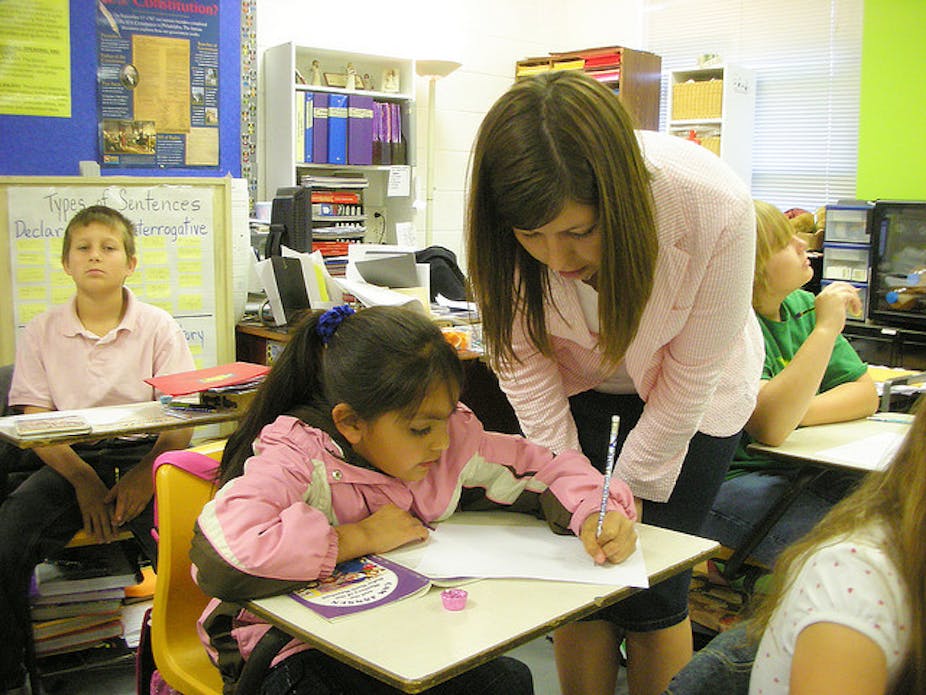It sounds like a good idea on paper. Teach for Australia is a federal government program designed to attract talented graduates into the teaching profession by providing a fast-track career change. Education minister Christopher Pyne is an enthusiastic supporter; he has just approved an extra $22 million for the program. The responses of academics and the teachers’ union, by contrast, have ranged from lukewarm to outright critical.
Melbourne University’s submission to the teacher education review disparaged programs like Teach for Australia as “five times more expensive than traditional programs”. Melbourne dean of education Field Rickards has since said that this comment was from a draft submission accidentally uploaded, and offered qualified support for programs such as Teach for Australia “provided there is convincing evidence of their effectiveness and sustainability”. But it’s hard not to see this backpedalling as motivated as much by an eye to the politics as by a genuine enthusiasm for the program.
The Australian Education Union has been even sharper in its criticism. The AEU characterises Teach for Australia as “an expensive failure”, “a distraction” and “a waste of money that will do nothing to help disadvantaged schools”. Comments such as these are difficult to reconcile with government enthusiasm.
So what does the research tell us about its effectiveness? The Australian Council for Education Research recently evaluated the program. This evaluation concluded that the program is successful in recruiting suitable, academically able graduates, some of whom would not have entered teaching by a regular pathway.
These teachers serve in schools that find it hard to attract quality graduates, particularly in STEM subjects (science, technology, engineering, mathematics). Although the first few school terms are challenging for graduates, principals regard them as effective teachers after one year and more effective than other graduate teachers by the end of their second year.
This evaluation doesn’t say that Teach for Australia is more effective than other approaches to teacher education. But this reflects the poor state of knowledge about the effectiveness of teacher education in general rather than the specifics of Teach for Australia.
A serious problem
Teacher education has been under siege for as long as I can remember. The current review led by Greg Craven is the most recent of more than 100 reports commissioned by Australian governments in the last 35 years.
Lately, the issue has become more pressing. Long-term scepticism about the impact of teacher education has been joined by new concerns about the declining academic quality of entrants to the teaching profession. Among students entering teacher education on the basis of their ATAR, the proportion with ATARs over 80 dropped from 45% in 2005 to 16% in 2012.
Some have argued that the brightest students do not necessarily make the best teachers. The opposite is equally likely to be true. Teachers who cannot master challenging academic content themselves are unlikely to be able to teach it, whatever their personal characteristics or life experience.
A partial solution
Teach for Australia takes this problem seriously. It recruits among academically able graduates, and selects candidates on the basis of personal qualities suitable for teaching and commitment to reducing educational disadvantage.
These candidates receive six weeks of formal preparation, followed by a two-year part-time teacher education program. Students undertake four-fifths of a full-time teaching load and are supported by an in-school mentor and external specialists and advisers.
Teach for Australia provides a benchmark for high-quality school-based teacher education. In a mass teacher education industry that - like the rest of higher education - has suffered from rising costs and falling income, it shows what can be done in a properly funded program.
And it shows that there is no conflict between extended practical experience in schools and an academically demanding teacher education program that meets national accreditation and registration requirements.
It is, however, a very small-scale and expensive intervention. Melbourne University’s Teach for Australia pathway provides just 50 graduates a year in an industry that produces more than 16,000 graduates annually. It costs just under $100,000 per graduate compared with an industry average of about $23,000. Perhaps the cost will be lower now that Deakin University has been awarded the contract to run Teach for Australia from 2015 to 2018.
Teach for Australia seems to work. It gets very able graduates with high levels of subject content knowledge into disadvantaged schools. It provides the mentoring and support to turn them into better-than-average new graduates.
But the program remains a small-scale and relatively expensive solution to the serious problem of recruiting high-quality graduates to the teaching profession.

